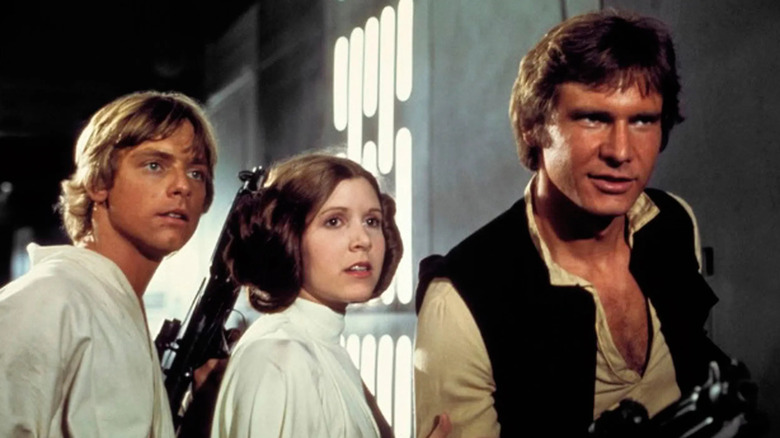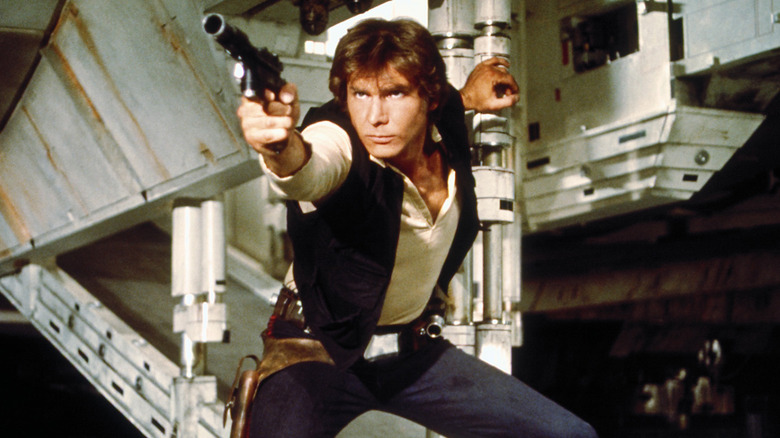George Lucas' First Screening Of The Star Wars Trailer Was A Total Flop
In a 2000 Star Wars Insider interview with "Star Wars: The Empire Strikes Back" director Irvin Kershner, he admits that he was initially reluctant to take on the project: "'Star Wars' was one of the greatest successes we ever had in film, and I felt to follow it would only be to make a film not as good." Even the studio did not want him to get involved with the sequel, feeling that Kershner was "too old, because it's a young person's film." He also knew next to nothing about special effects.
But as much of a success as "Star Wars" became, it was not initially received that way. In the same interview, Kershner recalls viewing a trailer at Francis Ford Coppola's New Year's Eve party: "We were all baffled, to tell you the truth. We did not believe that he was going to get away with this. We all had little conversations on the side — 'What do we say to him? It's a cartoon, not a real science-fiction picture!'"
There was another early screening for Lucas' filmmaker friends that has since become a Hollywood legend. According to Steven Spielberg in an interview with Empire Magazine, Brian DePalma was the most critical of the rough cut:
"When we went out to dinner afterwards, Brian began yelling at George: 'I DON'T UNDERSTAND YOUR STORY! THERE'S NO CONTEXT! WHAT IS THIS SPACE STUFF? WHO CARES? I'M LOST! ... This won't be commercial. Nobody will get it. It's just a void with stars and some silly ships moving around.'"
De Palma refuted this claim in a 2021 interview on the "Light the Fuse" podcast. Yet considering the film landscape during the mid-1970s, it's understandable why Lucas' peers were skeptical of his fantasy world of Wookies and lightsabers.
His epic vision was misunderstood
George Lucas was a member of the Movie Brats along with Francis Ford Coppola, Paul Schrader, Brian DePalma, John Milius, and Steven Spielberg, a group of notable directors who were bucking the traditions of classic Hollywood. Their films had a more naturalistic aesthetic with innovative and experimental camera techniques, narrative ambiguity, and gritty stories that often tackled provocative, socially relevant themes.
On the surface, this seems a galaxy far, far away from Lucas' melodramatic space opera, which paints its story and characters in very broad strokes. Kershner tells Star Wars Insider that he realized the value of this simplicity:
"It was supposed to be a fairy tale, with mythic qualities, using the elements of science fiction. But scientifically, it's full of baloney! It's a joke – which was wonderful, which is what makes it work. This is a film of good guys and bad guys, and that's what's good about it. ... [doing] research meant reading Freud and Jung on myths and fairy tales."
"Star Wars" aimed to capture the excitement and spectacle of classic adventure serials such as "Flash Gordon" and "Buck Rogers," but on a grander scale. Lucas had an epic vision for a story that all audiences could enjoy, drawn to the uplifting hero's journey narrative, vibrant characters, and majestic space battles with clear moral clarity. These deliberate choices by Lucas gave the film a distinctly crowd-pleasing and thrilling pulp style.
While such a departure from the New Hollywood style was initially misunderstood, George Lucas' fantastical odyssey ended up being just what audiences needed, earning $775 million and becoming a veritable phenomenon complete with theme parks, boundless merchandise, and an ever-expanding cinematic universe. His first screening may have been a flop, but Lucas proved himself as someone with a bold vision who redefined cinema in a significant way.

